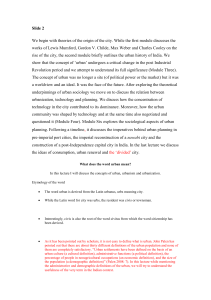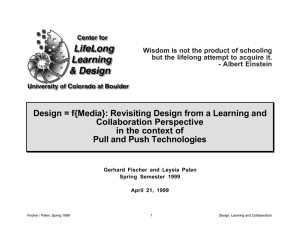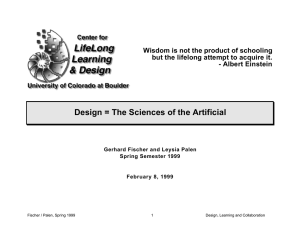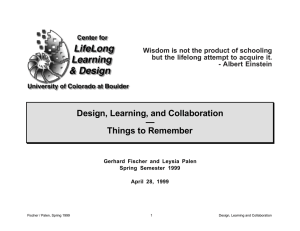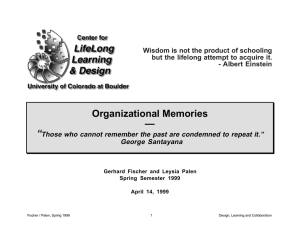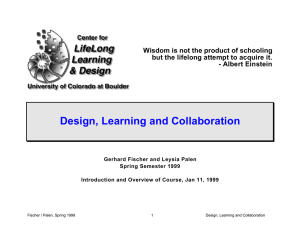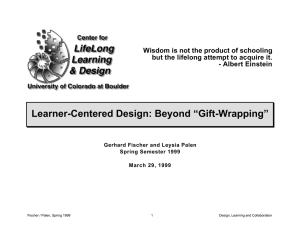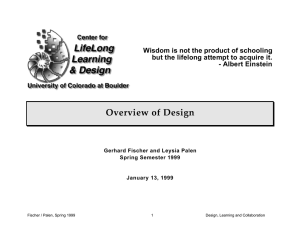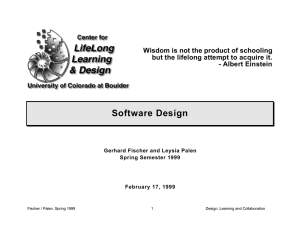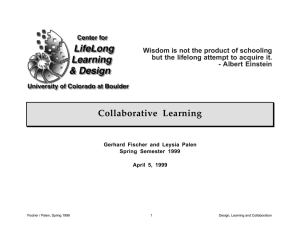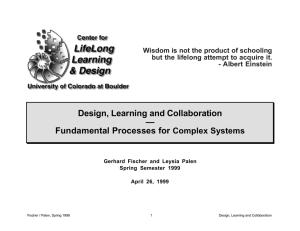Knowledge Management (KM) — Push and Push Technologies
advertisement
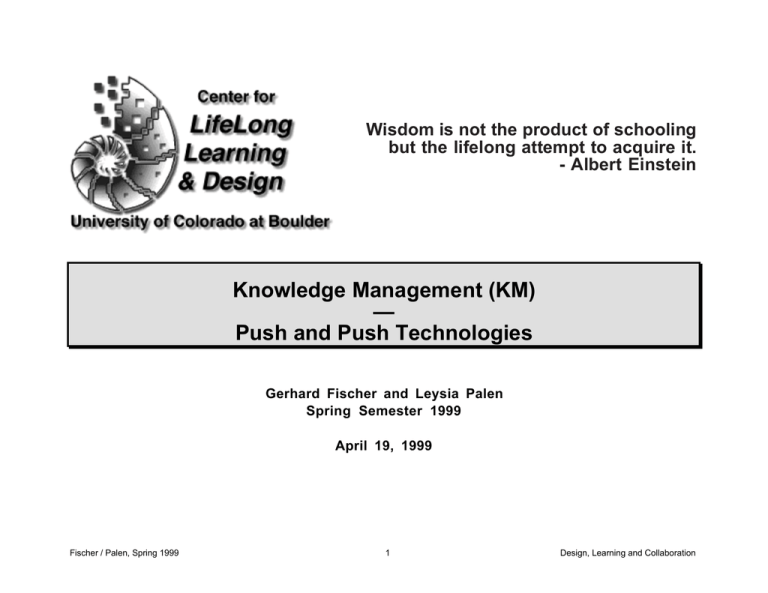
Wisdom is not the product of schooling but the lifelong attempt to acquire it. - Albert Einstein Knowledge Management (KM) — Push and Push Technologies Gerhard Fischer and Leysia Palen Spring Semester 1999 April 19, 1999 Fischer / Palen, Spring 1999 1 Design, Learning and Collaboration Major Processes in Knowledge Management Integration Knowledge Creation Fischer / Palen, Spring 1999 Dissemination 2 Design, Learning and Collaboration Knowledge Creation, Integration, and Dissemination • Creation: breakdowns (backtalk of the situation) symmetry of ignorance creating shared understanding solving problems at level 3 in the seeding, evolutionary growth, reseeding model against the background of level 2 • Integration: shared understanding externalizations (enriched) work products and the discourses about them information repositories and organizational memories • Dissemination learning on demand integration of working and learning contextualized information presentation knowledge delivery reflection-in-action / making argumentation serve design Fischer / Palen, Spring 1999 3 Design, Learning and Collaboration KM: Traditional versus New Models of Working and Learning in Organizations traditional new Paradigm knowledge transmission knowledge construction Learning classroom on demand Tasks system driven (canonical) user/task driven Social structures individuals in hierarchical collaborative in flat structures structures (communities of practice) Work style standardize improvise Information spaces closed, static open, dynamic Breakdowns errors to be avoided opportunity for innovation and learning Communication centralized, top-down decentralized, peer-to-peer Fischer / Palen, Spring 1999 4 Design, Learning and Collaboration L3D’sWork in KM: Theoretical and Conceptual Frameworks • knowledge acquisition ---> knowledge construction (breakdowns and symmetry of ignorance as sources for new knowledge) • closed system ---> open and evolvable systems (seeding, evolutionary growth, reseeding model, M1-M3 model of the WWW) • information ----> attention economy - saying the "right" thing at the "right" time in the "right" way - making information relevant to the task at hand - integration of working and learning and supporting learning on demand - supporting “reflection-in-action” and making argumentation serve design (critiquing) • complement information access (“pull” technologies) with information delivery (“push” technologies) • individual <---> social (group, organization): how do we effectively collect individual knowledge and make it accessible to the entire organization? Fischer / Palen, Spring 1999 5 Design, Learning and Collaboration The Seeding / Evolutionary Growth / Reseeding (SER) Model Le ge nd Art if act Evo lut io n bui l d on l owe r l evel Art if act A Client Domain Designer modi f y l ow er l evel Art if act B Environment Developer Do main Evolut io n Se e ding Evo lut io nar y G r owt h Re Se e ding Speci Matc fication h er Specif i cati on Co nce pt ual Fr amew or k Ev o lut io n Specificati on Catal og Exp ore lr Catal og Explor er A Ca talog t Construc ion lyzer Ana ation icSpeci f Matcher Cata l og Explor er rgum enta tion A Ca talog rgumen tion ta Argume ation nt ll ustrator I Argume ation nt ll ustrator I The Mult i facet ed A rc hit ect ure Fischer / Palen, Spring 1999 Construction t alog Ca plorer Ex 6 t i me Design, Learning and Collaboration Knowledge as Commodity • Postman, p 116 in “The End of Education”: “Knowledge is presented as a commodity to be acquired, never as a human struggle to understand, to overcome falsity, to stumble towards the truth” • John Thomas, IBM: "knowledge management" today seeks to continue and expand the trend of decontextualizing knowledge to a silly extent -- e.g., - the myth that we can simply "capture" the knowledge of a thirty-year expert in explicit form so we can fire the expert and hire someone with no relevant skills off the street who can now use the "knowledge base" to perform like an expert - the myth that in the ideal company, all knowledge will be captured worldwide and instantly fed via high band-width lines to a central place where globally optimal decisions can be made for the entire company and fed back out to the periphery for implementation Fischer / Palen, Spring 1999 7 Design, Learning and Collaboration L3D’s Work in KM: Systems Building Efforts of the Past Decade • Janus / KID: making argumentation serve design, embedded critiquing • Voice Dialog Design Environment: domain construction and controlling the intrusiveness of “pull technologies” • Network: incremental formalization (---> the artifact itself can be used to locate and access information in addition to browsing and search) • Indy: embedded communication, history mechanisms • location / comprehension / modification cycle: now applied to Gamelan, Educational Object Economy, Behavior Exchange • • Envisionment and Discovery Collaboratory: knowledge construction, shared understanding, integration of action and reflection space Fischer / Palen, Spring 1999 8 Design, Learning and Collaboration Voice Dialog Design Environment VM-Residential Fischer / Palen, Spring 1999 9 Design, Learning and Collaboration Embedded Communication (see assignment) Designing Communicating Computer stores the artifact Fischer / Palen, Spring 1999 Computer mediates design and communication 10 Design, Learning and Collaboration L3D’s Work in KM — Assessment • KM: new technology is necessary, but not sufficient ---> change of work practices, mindsets and reward structures is necessary - design rationale research - reuse versus “not invented here” - media competition • motivation for a group is different than for an individual - who is the beneficiary and who has to do the work? - utility = value /effort • engage skilled professionals in realistic work situations - requires useful and usable systems (not just demo systems) - prerequisite for evolutionary growth • “collaborative systems will not work in a non-collaborative society” a student’s observation in a class using technologies to enhance peerto-peer learning, sharing of information, self-evaluation, etc. Fischer / Palen, Spring 1999 11 Design, Learning and Collaboration Pull and Push Technologies pull push function information access information delivery examples passive help systems, search, browsing, bookmarks critiquing, active help systems, agent-based systems, broadcast systems systems WWW, Gamelan, Behavior Exchange DYK, Tip of the Day, Pointcast, How the West was Won strengths non-intrusive serendipity, unknown, relevant knowledge is offered weaknesses task relevant knowledge may remain hidden intrusiveness, decontextualized information major system design supporting users in challenges expressing queries, Fischer / Palen, Spring 1999 12 situation awareness, intent recognition, task models, user models Design, Learning and Collaboration New System Building Efforts Challenges GIMMe DynaSites objective Group Memory WWW Support for Collaborative Design Capture Email (captured with low effort) Explicit Effort, LSA, Browsing Structures Dynamic Structures, Restructuring Restructuring, Embedded Communication Access Sustain Fischer / Palen, Spring 1999 Persona ePost-it More Control and Expressibility Integration (via Glossary) 13 Design, Learning and Collaboration The Producer / Consumer Model Producer (Author) --------> | Societies accumulated | -----------> Consumer | knowledge | Input Filters Output filters input filters • to attempt that new knowledge is “consistent with already existing knowledge” , “socially accepted” or “useful at a given historical time” • to guard against erroneously adding “wrong” solutions, societies have been willing to accept high overhead costs caused by ancient priests, the holy inquisition, medieval librarians, an elaborated patent system, modern reviewing procedures for scientific papers ---> question: what do we have and what do we need for the WWW? • only knowledge that would pass these input filters would be allowed to enter the repositories of accumulated knowledge output filters: • to control the re-use of the accumulated knowledge • examples: guilds, professions, formal educational institutions Fischer / Palen, Spring 1999 14 Design, Learning and Collaboration
